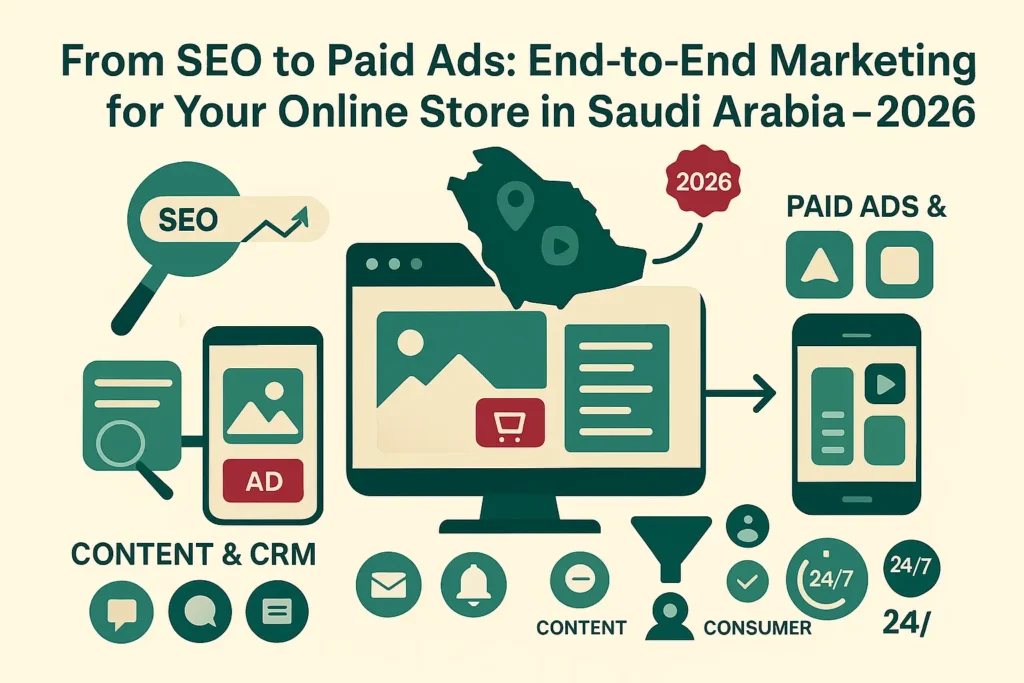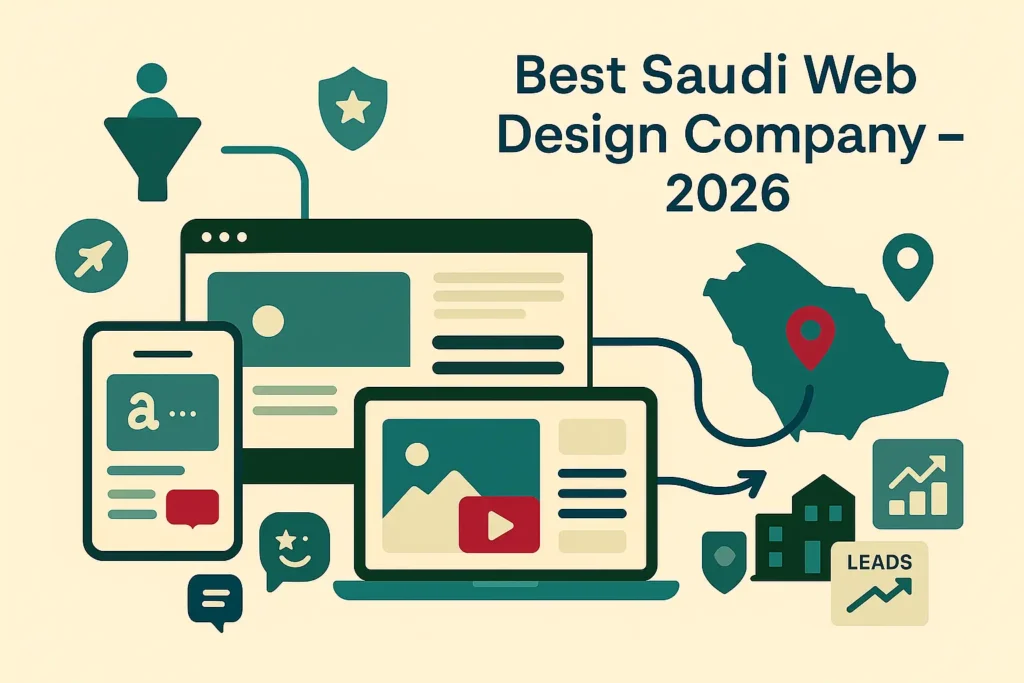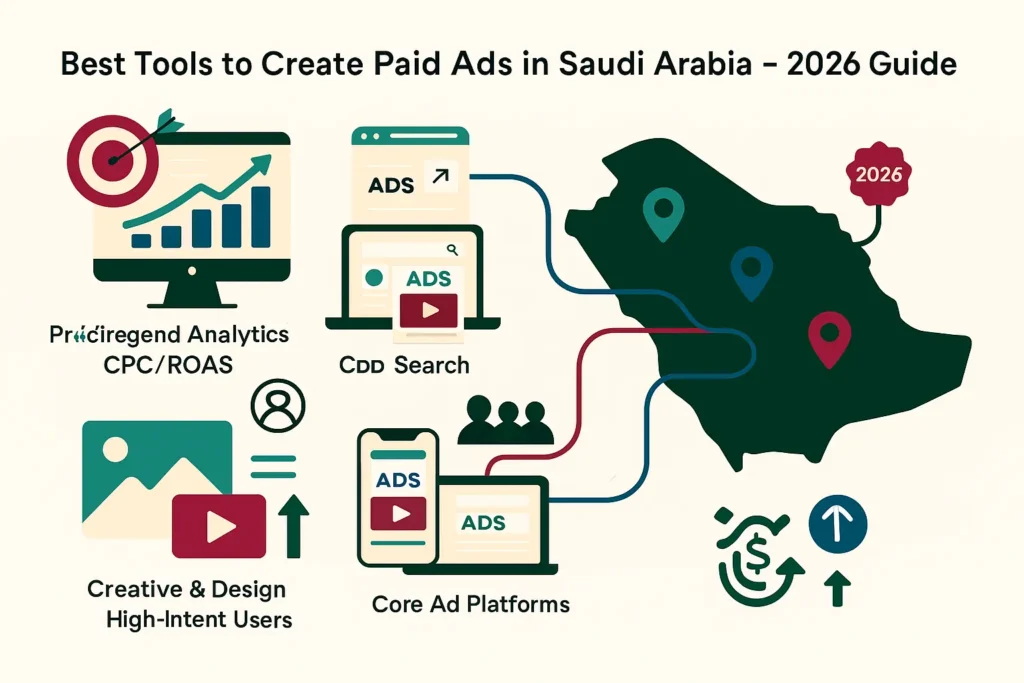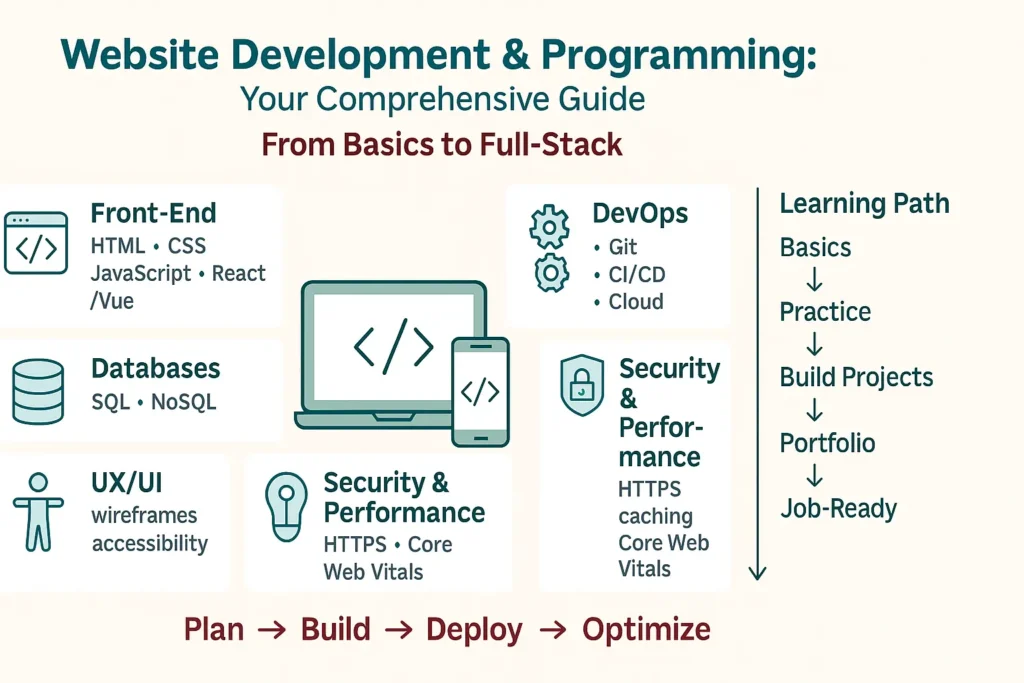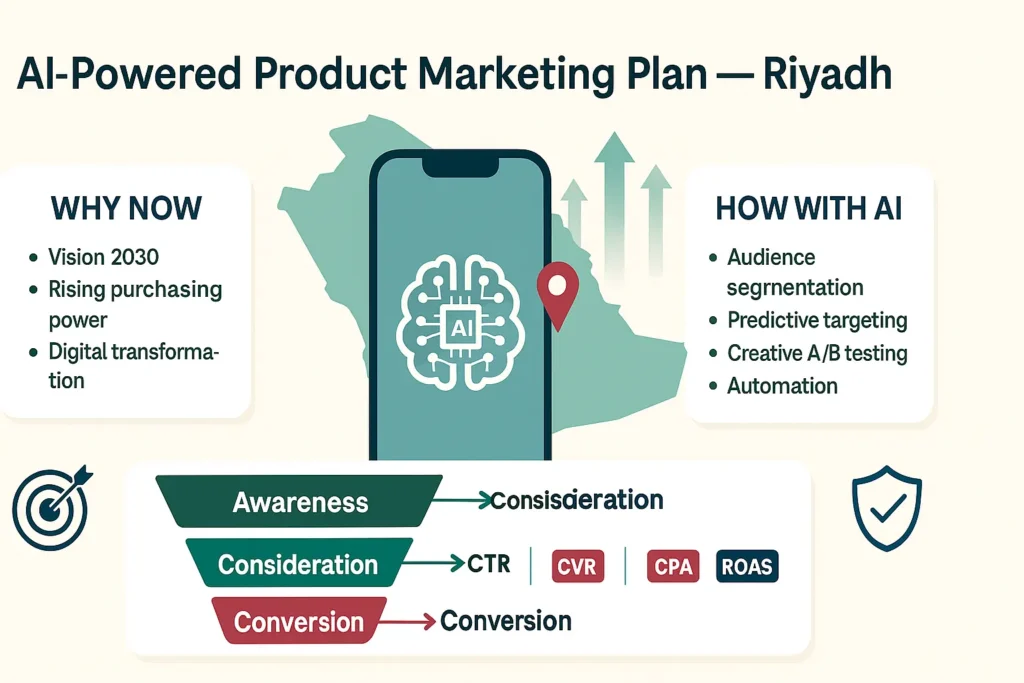
The best digital marketing services for entrepreneurs in the Arab world
Digital Marketing: What Arab Entrepreneurs Are Looking For
You’re witnessing an unprecedented digital transformation across the Middle East and North Africa, and the window of opportunity has never been wider. The explosive growth of digital adoption in the MENA region presents a golden opportunity that savvy entrepreneurs like yourself can’t afford to miss.
Mobile penetration rates in Gulf countries now exceed 95%, while e-commerce growth continues to outpace global averages by substantial margins. Your potential customers are increasingly spending their time and money online, with purchasing power rising steadily across key markets like Saudi Arabia, UAE, and Qatar.
Government initiatives across the region are actively supporting digital transformation, creating an ecosystem that favors forward-thinking businesses. The post-pandemic acceleration of online business models has fundamentally shifted consumer behavior. Digital marketing is not just an option but a necessity for sustainable growth.
As an entrepreneur in this space, you have the competitive advantage of being an early adopter in emerging markets where digital competition remains relatively sparse compared to Western markets. The cost of customer acquisition through digital channels is significantly lower, while the potential returns are exponentially higher.
Understanding the Arab Digital Landscape: Market Dynamics and Consumer Behavior
Your success in Arab markets depends heavily on understanding the unique demographics and digital consumption patterns across different countries. The region isn’t monolithic, and each market presents distinct opportunities and challenges that require tailored approaches.
Saudi Arabia’s Vision 2030 has created a surge in digital adoption, with over 90% of commerce now happening through mobile devices. The UAE continues to lead in digital innovation, while Egypt offers massive scale with its large population of digitally savvy millennials and Gen Z consumers.
Social media platform preferences vary significantly across the region. Instagram dominates visual content consumption, TikTok is rapidly gaining ground among younger demographics, and Snapchat maintains strong engagement rates in Gulf countries. Your content strategy must align with these platform-specific behaviors.
Language considerations extend beyond simple translation. While Modern Standard Arabic works across most markets, regional dialects and cultural nuances can significantly impact campaign effectiveness. Understanding when to use formal Arabic versus colloquial expressions can make or break your connection with local audiences.
Cultural factors deeply influence online purchasing decisions. Religious observances, family values, and social hierarchies all play crucial roles in how consumers interact with brands digitally. Your marketing approach must demonstrate cultural intelligence while maintaining authenticity.

Essential Digital Marketing Services Every Arab Entrepreneur Needs
Search Engine Optimization (SEO) for Arabic Markets
You’ll find that Arabic SEO presents unique opportunities in a relatively unclaimed digital space. Competition for Arabic keywords remains significantly lower than English counterparts, creating cost-effective pathways to organic visibility.
Technical considerations for Arabic websites include right-to-left text formatting, proper character encoding, and culturally appropriate visual design elements. Your SEO strategy must account for how Arabic users structure their search queries, often combining Arabic and English terms.
Modern Standard Arabic provides a broad reach across multiple markets, but incorporating regional dialects in your content can improve local search performance. FAQ sections using natural language patterns and local expressions tend to perform exceptionally well in voice search optimization.
Competitive analysis in Arabic search landscapes reveals opportunities that simply don’t exist in saturated English markets. You can often achieve first-page rankings for high-value keywords with focused effort and culturally relevant content creation.
Pay-Per-Click (PPC) Advertising Excellence
Google Ads optimization for Arabic campaigns requires understanding the cultural context behind keyword selection. Direct translations rarely capture search intent effectively, requiring native-level language skills combined with marketing expertise.
Cost-effective targeting strategies focus on geographic specificity rather than broad regional approaches. Campaigns targeting specific cities or emirates often outperform country-level targeting by significant margins, allowing for more precise budget allocation.
Ad copywriting that resonates with Arab consumers emphasizes trust, quality, and cultural relevance. Your messaging must demonstrate understanding of local values while clearly communicating value propositions that matter to regional audiences.
Budget allocation across different Arabic-speaking markets should reflect varying cost structures and conversion potentials. UAE and Saudi Arabia typically require higher cost-per-click investments but offer superior conversion rates and customer lifetime values.
Social Media Marketing Mastery
Platform-specific strategies require deep understanding of how different Arab audiences engage with content. Instagram’s visual storytelling capabilities align perfectly with cultural preferences for rich, image-based communication.
Content creation must respect cultural values while remaining engaging and shareable. Your social media presence should reflect an understanding of appropriate imagery, messaging tone, and cultural sensitivities that vary between conservative and liberal markets.
Community building requires consistent engagement using culturally appropriate communication styles. Arab audiences value personal connections and authentic interactions, making community management a crucial component of social media success.
Influencer collaboration approaches should prioritize micro-influencers with genuine cultural connections over celebrity endorsements. Authentic voices from within target communities generate significantly higher engagement rates and conversion potential.
Leveraging AI and Technology for Competitive Advantage
Artificial intelligence is transforming digital marketing capabilities across the MENA region, with AI sector growth projected to exceed 43% annually through 2033. Your ability to integrate these technologies effectively will determine your competitive positioning.
AI-powered customer segmentation allows for unprecedented personalization in Arabic markets. Machine learning algorithms can identify cultural preferences, purchasing patterns, and engagement behaviors that human analysis might miss.
Automated content creation tools now support Arabic language generation, but human oversight remains essential for cultural authenticity. Your AI strategy should augment rather than replace human creativity and cultural intelligence.
Voice search optimization for Arabic queries presents emerging opportunities as smart speaker adoption increases. Your content strategy must account for how Arabic speakers naturally formulate voice searches, often mixing languages and using conversational tones.
Visual search capabilities are particularly relevant for product discovery in image-focused Arab markets. Optimizing your product imagery and implementing proper tagging strategies can capture significant traffic from visual search platforms.
Platform-Specific Strategies for Maximum Impact
Instagram and Visual Storytelling
Creating culturally relevant visual content requires understanding color psychology, imagery preferences, and visual storytelling traditions that resonate with Arab audiences. Your Instagram strategy should reflect these cultural nuances while maintaining brand consistency.
Stories and Reels optimization focuses on authentic, behind-the-scenes content that builds trust with Arab consumers. Cultural celebrations, team introductions, and process demonstrations tend to generate high engagement rates.
Shopping features and e-commerce integration work exceptionally well in Arab markets, where social commerce adoption rates exceed global averages. Your product catalog optimization should emphasize high-quality imagery and clear pricing in local currencies.
Influencer partnerships require careful vetting to ensure cultural alignment and authentic audience connections. Micro-influencers with genuine community ties often deliver superior results compared to celebrity endorsements.
TikTok and Short-Form Content
Understanding Gen Z behavior in Arab markets reveals a preference for entertaining, authentic content that speaks to their specific cultural experiences. Your TikTok strategy should embrace local humor, trending topics, and culturally relevant challenges.
Trending content formats must be adapted for cultural appropriateness while maintaining viral potential. Arabic-language content that incorporates regional dialects and cultural references tends to achieve higher engagement rates.
Hashtag strategies for Arabic content should combine trending global tags with region-specific terms. Your hashtag research must account for Arabic script variations and common transliteration patterns.
Brand safety considerations require understanding cultural sensitivities around content topics, imagery, and messaging approaches. Your content guidelines should reflect deep cultural awareness to avoid potentially offensive material.
LinkedIn for B2B Success
Professional networking in Arabic business culture emphasizes relationship building and trust development over aggressive sales approaches. Your LinkedIn strategy should focus on providing value and establishing credibility within professional communities.
Content marketing for Arabic-speaking professionals requires understanding career development priorities, industry challenges, and professional aspirations specific to MENA markets. Your content calendar should reflect these professional interests.
Lead generation strategies must account for longer relationship-building cycles common in Arab business culture. Your approach should emphasize patience, consistency, and genuine value delivery over quick conversion tactics.
Industry-specific targeting allows for highly focused campaigns that speak directly to professional challenges and opportunities within specific sectors. Your targeting strategy should leverage LinkedIn’s advanced professional demographic options.

Cultural Intelligence: The Key to Authentic Marketing
Understanding religious considerations opens opportunities for meaningful engagement during significant periods like Ramadan and Eid. Your marketing calendar should integrate these cultural moments naturally rather than appearing opportunistic.
Ramadan marketing strategies require sensitivity to fasting practices while recognizing increased evening social media activity and shopping behaviors. Your content scheduling and promotional timing should reflect these behavioral patterns.
Color psychology in Arab markets differs significantly from Western interpretations. Green often represents prosperity and Islam, while gold conveys luxury and success. Your visual design choices should reflect these cultural color associations.
Humor and storytelling approaches must navigate cultural boundaries while remaining engaging and memorable. Self-deprecating humor rarely translates well, while family-oriented storytelling tends to resonate strongly across Arab cultures.
Gender-specific marketing requires understanding varying cultural norms across different Arab markets. Conservative markets may require separate messaging approaches, while more liberal markets allow for integrated campaigns.
Budget Optimization and ROI Maximization Strategies
Cost-effective channel selection depends on your specific business type and target audience characteristics. B2B services often achieve better ROI through LinkedIn and Google Ads, while consumer brands typically perform better on Instagram and TikTok.
Budget allocation frameworks should account for testing phases, optimization periods, and scaling opportunities. Your initial budget distribution might allocate 60% to proven channels and 40% to experimental approaches.
Performance tracking requires establishing KPIs that reflect Arab market behaviors and cultural preferences. Standard conversion metrics should be supplemented with engagement quality, cultural sentiment, and brand perception measurements.
Scaling successful campaigns across multiple markets requires understanding cost variations and competitive landscapes in each region. Your expansion strategy should prioritize markets with proven demand and manageable competition levels.
Outsourcing versus in-house team considerations depend on your long-term market commitment and resource availability. Cultural expertise and language skills often justify outsourcing to specialized agencies with regional experience.
Industry-Specific Digital Marketing Approaches
Healthcare and Medical Tourism
Targeting Arab patients requires understanding healthcare decision-making processes that often involve family consultation and extensive research. Your patient journey mapping should account for these cultural factors.
Building trust through testimonials and credentials requires careful attention to privacy concerns and cultural sensitivities around health discussions. Your social proof strategy should emphasize professionalism and cultural competence.
Compliance considerations vary significantly across Arab countries, with some requiring specific licensing or approval processes for healthcare marketing. Your campaign development should incorporate legal review and regulatory compliance.
Multilingual patient journey optimization should provide seamless experiences across Arabic and English touchpoints. Your website architecture should support easy language switching without losing user context or progress.
Education and Training
Attracting Arab students requires understanding educational priorities, family decision-making processes, and cultural preferences for learning environments. Your marketing messages should address these specific concerns and motivations.
Professional development marketing should emphasize career advancement opportunities and skills that align with regional economic development priorities. Your course positioning should connect to local job market demands.
Cultural adaptation of educational content requires understanding learning styles, communication preferences, and cultural examples that resonate with Arab audiences. Your content development should reflect these educational cultural nuances.
E-commerce and Retail
Product localization extends beyond language translation to include cultural preferences, sizing standards, and feature prioritization that matters to Arab consumers. Your product presentation should reflect these regional preferences.
Payment gateway optimization should support preferred payment methods, including cash on delivery, bank transfers, and regional payment platforms. Your checkout process should minimize friction while maintaining security.
Customer service excellence requires Arabic language support and cultural competence in handling inquiries and complaints. Your support team should understand cultural communication styles and service expectations.
Overcoming Common Challenges and Pitfalls
Language barriers extend beyond translation to include cultural context, appropriate tone, and regional dialect considerations. Your content creation process should involve native speakers with marketing expertise rather than just translators.
Cultural misunderstandings can damage brand reputation quickly in close-knit Arab communities. Your campaign review process should include cultural sensitivity audits by local experts before launch.
Platform restrictions vary across Arab countries, with some social media platforms facing intermittent access issues. Your digital strategy should include backup platforms and content distribution alternatives.
Payment processing complications often arise from international banking regulations and fraud prevention measures. Your e-commerce setup should work with regional payment processors familiar with local banking systems.
Team building challenges include finding professionals with both digital marketing skills and cultural competence. Your hiring strategy should prioritize cultural fit alongside technical capabilities.
Future-Proofing Your Digital Marketing Strategy
Emerging technologies, including augmented reality, virtual reality, and advanced AI. Will create new marketing opportunities in Arab markets. Your technology adoption strategy should balance innovation with cultural appropriateness.
Changing consumer behaviors post-2025 will likely include increased privacy awareness, sustainable consumption preferences, and demand for authentic brand experiences. Your long-term strategy should anticipate these evolving expectations.
New platform opportunities may emerge from regional tech development or global platform expansion into Arab markets. Your platform strategy should remain flexible enough to capitalize on emerging opportunities.
Regulatory changes across Arab countries may affect digital marketing practices, data collection, and advertising standards. Your compliance strategy should include regular legal review and policy updates.
Cross-border e-commerce expansion will become increasingly important as regional integration deepens. Expansion planning should consider logistics, regulations, and cultural variations across target markets.
Curious how digital marketing is transforming the business landscape? Read more in our next article.
Your Digital Success Journey Starts Today: Taking Action in the Arab Market
Your path to digital marketing success in Arab markets begins with taking decisive action based on the insights and strategies outlined throughout this guide. The opportunity window in MENA markets won’t remain open indefinitely, and early movers consistently capture the greatest returns.
Start by conducting thorough market research to identify your most promising target segments within the broader Arab market. Focus on one or two countries initially rather than attempting to tackle the entire region simultaneously. This focused approach allows for deeper cultural understanding and more effective resource allocation.
Choose digital marketing partners who demonstrate genuine cultural competence alongside technical expertise. Agency selection should prioritize Arabic language capabilities, regional market experience, and proven track records with businesses similar to yours.
Building internal capabilities requires investing in team members who understand both digital marketing best practices and Arab cultural nuances. Your hiring strategy should emphasize cultural intelligence as much as technical skills.
Setting realistic expectations
includes understanding that Arab markets often require longer relationship-building periods but deliver higher customer lifetime values. Your success metrics should reflect these market characteristics rather than applying Western benchmarks.
Creating scalable systems means developing processes that can expand across multiple Arab markets while maintaining cultural authenticity. Your operational framework should support growth without sacrificing the personal touch that Arab consumers value.
Your long-term vision should encompass regional market dominance through consistent value delivery, cultural respect, and authentic engagement with Arab communities. Success in these markets requires patience, persistence, and genuine commitment to serving Arab consumers effectively.
The digital transformation of Arab markets represents one of the most significant business opportunities of our generation. Your willingness to invest in understanding these markets, respecting their cultures, and delivering genuine value will determine your success in capturing this opportunity.
Frequently Asked Questions (FAQ)
What’s the most cost-effective digital marketing service for Arab entrepreneurs just starting out?
Search Engine Optimization combined with organic social media marketing typically offers the best return on investment for beginners. The Arabic search landscape remains relatively unclaimed compared to English markets. Creating opportunities for cost-effective organic visibility. Social media platforms like Instagram and TikTok allow for authentic engagement with Arab audiences without requiring substantial advertising budgets.
Do I need to create separate Arabic websites for different Arab countries?
Modern Standard Arabic works effectively across most Arab markets, eliminating the need for separate websites in many cases. However, creating localized landing pages for specific countries can significantly improve conversion rates by addressing local preferences, currencies, and cultural nuances. Your approach should depend on your target market scope and available resources.
How long does it take to see results from Arabic digital marketing campaigns?
Pay-per-click advertising campaigns can generate results within days of launch. Particularly in less competitive Arabic markets. Search engine optimization and organic social media marketing typically require 3-6 months to show a significant impact. The timeline often depends on your industry competitiveness and the consistency of your content creation efforts.
Should I work with local agencies or international ones for the Arab market expansion?
Local agencies offer irreplaceable cultural expertise, native language capabilities, and a deep understanding of regional market dynamics. International agencies may provide broader strategic experience but often lack the cultural nuance necessary for authentic Arab market engagement. The optimal approach often involves partnering with local agencies that have international experience and proven track records.
What’s the biggest mistake entrepreneurs make when entering Arab digital markets?
The most common error is assuming that direct translation of existing campaigns will work without cultural adaptation. Successful Arab market entry requires understanding cultural context, religious considerations, and family dynamics. And communication styles that differ significantly from Western approaches. Your marketing strategy must be culturally intelligent, not just linguistically translated.
How do I measure success across different Arabic-speaking markets?
Use region-specific key performance indicators that reflect local market behaviors and cultural preferences. Standard conversion metrics should be supplemented with engagement quality measurements, cultural sentiment analysis, and brand perception tracking. Your success measurement framework should account for longer relationship-building cycles common in Arab business culture while tracking progress toward meaningful business objectives.
Take your business to the next level — start your digital marketing journey with trusted professionals today!




